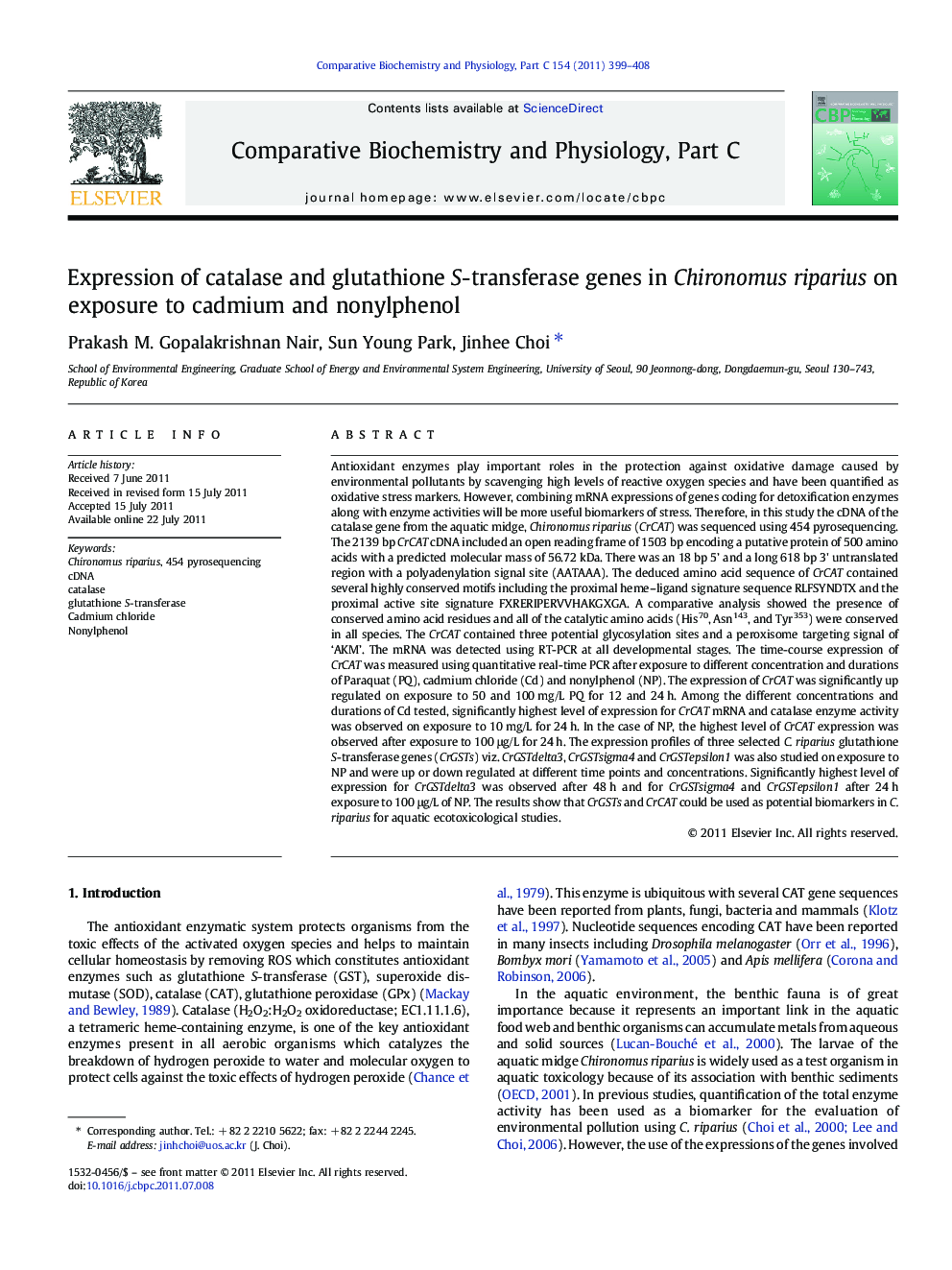| کد مقاله | کد نشریه | سال انتشار | مقاله انگلیسی | نسخه تمام متن |
|---|---|---|---|---|
| 10821702 | 1061493 | 2011 | 10 صفحه PDF | دانلود رایگان |
عنوان انگلیسی مقاله ISI
Expression of catalase and glutathione S-transferase genes in Chironomus riparius on exposure to cadmium and nonylphenol
دانلود مقاله + سفارش ترجمه
دانلود مقاله ISI انگلیسی
رایگان برای ایرانیان
کلمات کلیدی
موضوعات مرتبط
علوم زیستی و بیوفناوری
بیوشیمی، ژنتیک و زیست شناسی مولکولی
زیست شیمی
پیش نمایش صفحه اول مقاله

چکیده انگلیسی
Antioxidant enzymes play important roles in the protection against oxidative damage caused by environmental pollutants by scavenging high levels of reactive oxygen species and have been quantified as oxidative stress markers. However, combining mRNA expressions of genes coding for detoxification enzymes along with enzyme activities will be more useful biomarkers of stress. Therefore, in this study the cDNA of the catalase gene from the aquatic midge, Chironomus riparius (CrCAT) was sequenced using 454 pyrosequencing. The 2139 bp CrCAT cDNA included an open reading frame of 1503 bp encoding a putative protein of 500 amino acids with a predicted molecular mass of 56.72 kDa. There was an 18 bp 5' and a long 618 bp 3' untranslated region with a polyadenylation signal site (AATAAA). The deduced amino acid sequence of CrCAT contained several highly conserved motifs including the proximal heme-ligand signature sequence RLFSYNDTX and the proximal active site signature FXRERIPERVVHAKGXGA. A comparative analysis showed the presence of conserved amino acid residues and all of the catalytic amino acids (His70, Asn143, and Tyr353) were conserved in all species. The CrCAT contained three potential glycosylation sites and a peroxisome targeting signal of 'AKM'. The mRNA was detected using RT-PCR at all developmental stages. The time-course expression of CrCAT was measured using quantitative real-time PCR after exposure to different concentration and durations of Paraquat (PQ), cadmium chloride (Cd) and nonylphenol (NP). The expression of CrCAT was significantly up regulated on exposure to 50 and 100 mg/L PQ for 12 and 24 h. Among the different concentrations and durations of Cd tested, significantly highest level of expression for CrCAT mRNA and catalase enzyme activity was observed on exposure to 10 mg/L for 24 h. In the case of NP, the highest level of CrCAT expression was observed after exposure to 100 μg/L for 24 h. The expression profiles of three selected C. riparius glutathione S-transferase genes (CrGSTs) viz. CrGSTdelta3, CrGSTsigma4 and CrGSTepsilon1 was also studied on exposure to NP and were up or down regulated at different time points and concentrations. Significantly highest level of expression for CrGSTdelta3 was observed after 48 h and for CrGSTsigma4 and CrGSTepsilon1 after 24 h exposure to 100 μg/L of NP. The results show that CrGSTs and CrCAT could be used as potential biomarkers in C. riparius for aquatic ecotoxicological studies.
ناشر
Database: Elsevier - ScienceDirect (ساینس دایرکت)
Journal: Comparative Biochemistry and Physiology Part C: Toxicology & Pharmacology - Volume 154, Issue 4, November 2011, Pages 399-408
Journal: Comparative Biochemistry and Physiology Part C: Toxicology & Pharmacology - Volume 154, Issue 4, November 2011, Pages 399-408
نویسندگان
Prakash M. Gopalakrishnan Nair, Sun Young Park, Jinhee Choi,